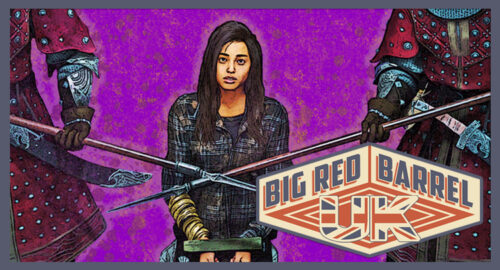It’s been a long time coming: after half a decade of waiting and an obsession with off-road rallying and Formula One, Codemasters has seen fit to return to the world of mainstream circuit racing. GRID 2 is a Race Driver sequel of refined proportions and deeply considered concessions, the ultimate goal of which was to produce a streamlined and no-nonsense racing title. In this respect, Codemasters has succeeded.
• Developer: Codemasters
• Publisher: Codemasters
• Reviewed on: PlayStation 3
• Also Available On: Xbox 360, PC
• Release Date: Available Now

There’s little to distract you from the action on track, for starters. The menus, as pretty as they are inside the various garages you build during your illustrious racing career, serve as little more than a simple backdrop for the handful of button presses it takes to jump from race to race. The heads-up display is minimalist and the space it takes up the very antithesis of invasive. The excess of DiRT is gone.
In place of any excess is a very pure track experience. The Codies-penned ‘TrueFeel’ handling model is fast and ready. There are enough distinguishing parameters on each car to seperate them from one another, so a drift-happy Ford Mustang feels a lot different from a grippy Audi roadster. Even then, the lighter tail-happy cars grab the road differently from throaty muscle cars which lurch along it above all else.
The game encourages aggressive driving and powerslides where possible, much like Race Driver before it, and this approach is immediately accessible and very easy to grasp. There’s a great balance struck between fun and technical skill: corrections can be made with the throttle, brake and counter-steering without issue but it is possible, with practice, to string corners together with ease and an earned sense of self-satisfaction.

From European sports saloons to American muscle and Japanese roadsters, GRID 2 has it all.
Guiding your car through each circuit is a joy every time. Winding mountain circuits become a test of maintaining momentum while the tight city circuits of Chicago and Paris test your handbrake turns. By conceding the cockpit camera view in the name of graphical fidelity, Codies have been able to squeeze large amounts of detail out of the tracks. Draw distances are massive, crowds are fully realised and plentiful and road surfaces are filled with tiny, reactive details – flooring it over ventilation grates and feeling the car buckle on the metal is always a highlight of the city tracks.
The fidelity of the visuals transfers astonishingly well to the split-screen multiplayer, which features every car and track encountered in the single-player career mode. This would go some way to explain the lack of the interior view. However, when Shift 2 managed comparable visuals two years ago with a fully-detailed interior camera, you sometimes have to wonder exactly what Codies are doing with their graphics engine to get so little out of it.
When inevitable spinouts and ludicrous crashes happen – and they will – the development team have seen fit to even refine getting back onto the track. The ‘Flashback’ system seen in every Codies racing title as of late returns, but opts for a Forza-inspired instant rewind in which your progress is reversed in real time until you give the prompt to resume. It’s far smoother than the process of old that saw you navigate replay menu controls to find your preferred point of resumption. It’s a lot better for it too.
Where GRID 2‘s action falters is in its single-player campaign. What initially starts off as exciting and regular gratification in the form of new cars becomes something of a slog. Cars become mere collectibles and the challenges required to earn half of them become chores rather than enjoyable tasks. The wafer-thin plotline sees you pitched as a jack-of-all-trades poster boy for a fictional racing league, flying across the world to bring racing teams in and generate fans and coverage courtesy of a heavily present real-world sports broadcaster. The excesses of sponsorship and the variety of events are there – drift contests, point to point challenges, timed runs – but it all feels a little empty when your car collection begins to swell.

While the interior camera is missed – Codies cite user stats to show nobody used it – it’s not a game-ruining omission.
The real satisfaction comes from online competitive multiplayer, spun off as a separate entity. Here, you are given money and a handful of starter cars and let loose on the world. Alongside customisable and pre-made races, all of which count towards your online rank, GRID 2 assigns you challenges against randomly selected opponents from across the world, changing the opponents and the challenges every week. Avoiding the alienation made possible by Need for Speed‘s Autolog is the clear intention here – it’s all too easy to find yourself with nobody to compete against if your friends don’t play Most Wanted.
GRID online is a more rewarding and personal experience as well. Each car can be upgraded cosmetically and under the hood; there’s a greater sense of pride as you drive your personalised car around the tracks ahead of presumably envious competition. There’s a real sense of ownership that comes with every car you save up for and buy. That’s something really missing from the greedier, hoarder-sequel single-player.
When all is said and done, there’s no denying that hooning around in GRID 2 is a lot of fun. The handling strikes an ideal balance between fun and technical skill. The game is very pretty. The cockpit camera is not missed too much. There’s moreish multiplayer and split-screen competition. There’s plenty to love in GRID 2, but the tiresome single-player has a lot to answer for – and with Codemasters’ experience you can’t help but wonder if they could have done more with it.







Darth Nutclench
Agree with most of your points, Jon, but I don’t think it’s pretty. I find myself quite disappointed by the way it looks, considering how new the game is. I wonder if Codemasters did a half-baked job of the design as they’re already working on a next-gen title?